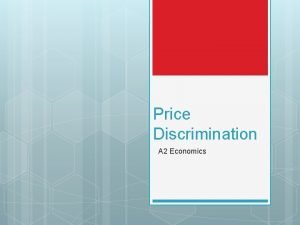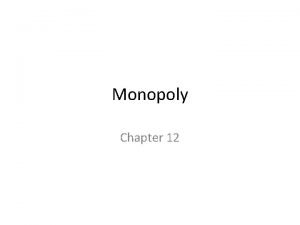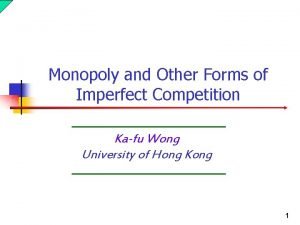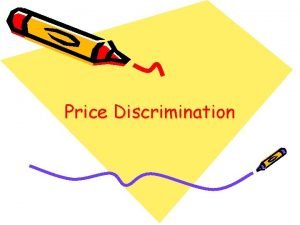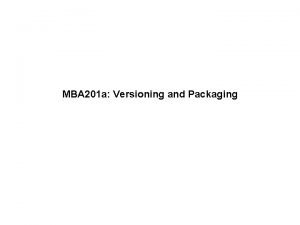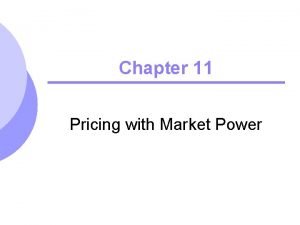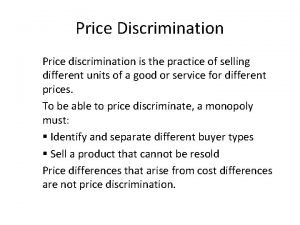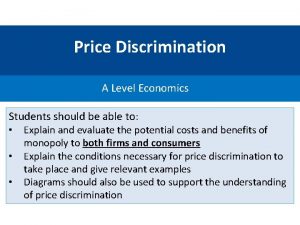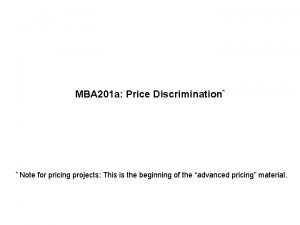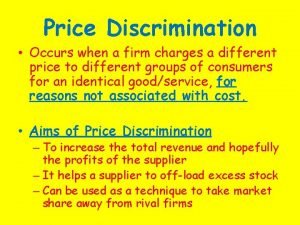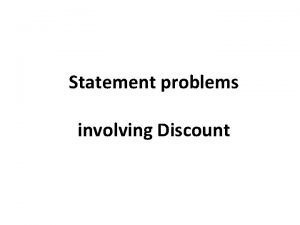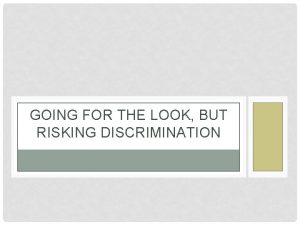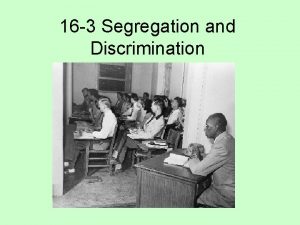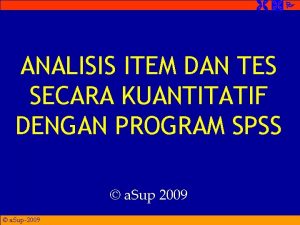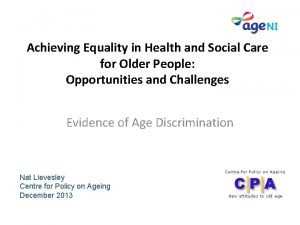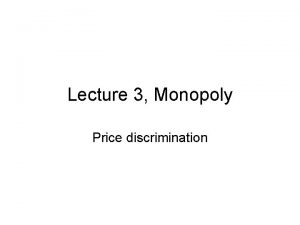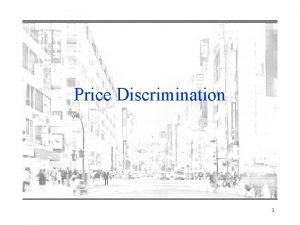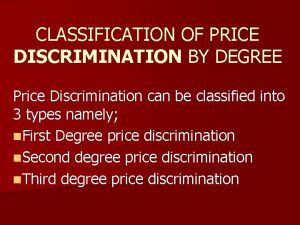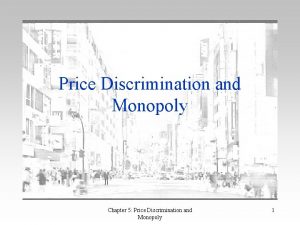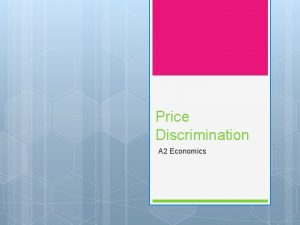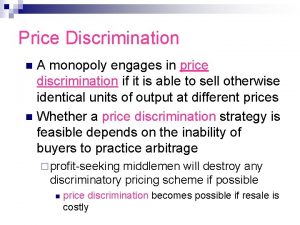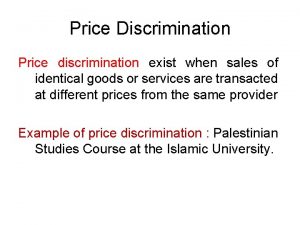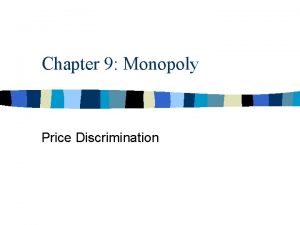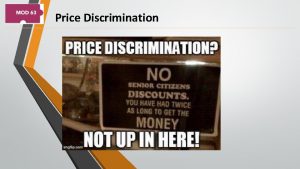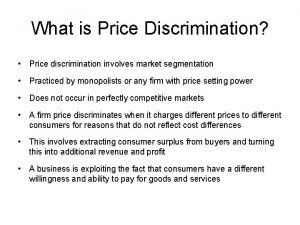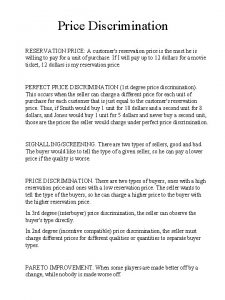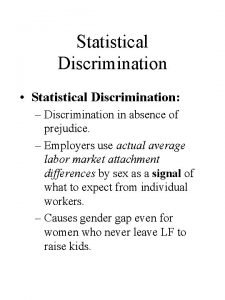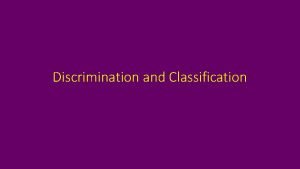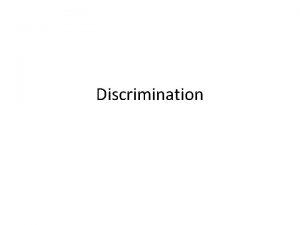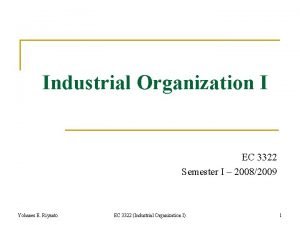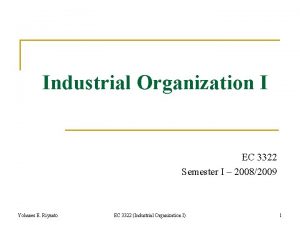Topic 10 Price Discrimination EC 3322 Semester I









































- Slides: 41

Topic 10: Price Discrimination EC 3322 Semester I – 2008/2009 Yohanes E. Riyanto EC 3322 (Industrial Organization I) 1

Introduction n Price discrimination the use of non-uniform pricing to max. profit: q Charging consumers different prices for the same product. q Charging a consumer a price which varies with the quantity bought. n Not all price differences reflect price discrimination cost differential of supplying the products to different group of consumers. n Examples: q q Magazines, movie or museums tickets sold at normal price and concession price for students and senior citizens. The use of rebate coupons. Prescription drugs, music CDs, or movie DVDs are cheaper in some countries. Gasoline price in Singapore and in Johor. Business and first class travel vs. economy class. Yohanes E. Riyanto EC 3322 (Industrial Organization I) 2

Introduction … n Why price discrimination is profitable? because consumers have different valuations (willingness-to-pay/ WTP) those with higher valuations pay more in contrast to the uniform pricing. n Conditions for successful price discrimination policy: q q q The firm adopting the policy must have some market power (able to set p>MC). The firm must be able to distinguish consumers on the basis of their WTP this WTP must vary across consumers and (or) units purchased. The firm must be able to prevent arbitrage or resale from consumers who pay at a lower price to consumers who are willing to pay a higher price. Yohanes E. Riyanto EC 3322 (Industrial Organization I) 3

Price Discrimination n There are three different types of price discrimination: q q q First-degree price discrimination (or personalized pricing) Each consumer pays a different price depending on the WTP consumers are left with no consumer surplus. Second-degree price discrimination (or menu pricing) the price per unit depends on the number of units purchased the firm is not able to capture all consumer surplus. Third-degree price discrimination (group pricing) each group of consumers faces its own price per unit the firm is not able to capture all consumer surplus. Yohanes E. Riyanto EC 3322 (Industrial Organization I) 4

Price Discrimination … n Specific examples of price discrimination strategies: q q Two-Part Tariff : The firm charges a lump-sum fee (the first part of the tariff) for the right to participate in the transaction, and a price per unit of product (the second part) e. g. amusement/ theme parks, cover charge in clubs. Quantity Discount price discount for large purchases e. g. buy 2 get 1 free scheme. Tie-in-Sale a consumer can buy one product only if another product is also bought e. g. coffee machine that requires a special coffee capsule from the company. Quality Discrimination selling different qualities to different type of consumers. Yohanes E. Riyanto EC 3322 (Industrial Organization I) 5

First Degree Price Discrimination n A monopolist can charge maximum price that each consumer is willing to pay extracts all consumer surplus. n Profit = total surplus first-degree price discrimination is efficient. p ($) p’ consumer surplus profit dead weight loss (DWL) pm pc MR Q* Yohanes E. Riyanto firm charges all consumers, except the marginal consumer, Price > MC. MC p(q) q profit pc EC 3322 (Industrial Organization I) MR Q* MC p(q) q 6

First Degree Price Discrimination … n First-degree price discrimination is highly profitable but requires detailed information and ability to avoid arbitrage. n It leads to the efficient choice of output. n But there are other pricing schemes that will achieve the same outcome: q q Non-Linear Prices (e. g. two-part pricing, in which a lumpsum fee (membership fee) and a per unit price are charged. Block Pricing bundle total charge and quantity in a package. Yohanes E. Riyanto EC 3322 (Industrial Organization I) 7

Two-Part Pricing n Consider the following example St. James Power Station Club serves two types of customers; teenagers (t) and young professionals (p). q q Teenagers The demand for entry plus Qt drinks is P = Vt – Qt q There are equal numbers of each type. q q n Young professionals The demand for entry plus Qy drinks is P = V y – Qy Assume that Vy > Vt young professionals are willing to pay more than teenagers. Cost of operation of the club: C(Q) = F + c. Q The demand costs are all expressed in daily units Yohanes E. Riyanto EC 3322 (Industrial Organization I) 8

Two-Part Pricing … n Suppose that the club owner applies “traditional” linear pricing free entry (no cover charge) and a set price for drinks. q The aggregate demand is QU = Qy + Qt = (Vy + Vt) – 2 PU q The inverse demand is PU = (Vy + Vt)/2 – QU/2 q MR = (Vy + Vt)/2 – QU q MR = MC, MC = c and solve for Q to give QU = (Vy + Vt)/2 – c q Substitute into the aggregate demand to give the equilibrium price PU = (Vy + Vt)/4 + c/2 q Each young professional buys Qy = (3 Vy – Vt)/4 – c/2 drinks. q Each teenager buys Qy = (3 Vy – Vt)/4 – c/2 drinks. q Profit from each pair of the young pro. and teenager is U = (Vy + Vt – 2 c)2 Yohanes E. Riyanto EC 3322 (Industrial Organization I) 9

Two-Part Pricing … This example can be illustrated as follows (the demand from each customer): (a) Young Professionals Price Vy (b) Teenagers Price Vy a e Vt d (c) Young Pro/ Teenager pair of customers b f V y+V t + c 4 2 g c h i k j MC MR Quantity Vy Quantity Vt Vy+V t -c 2 Quantity Vy + Vt Linear pricing leaves each type of consumer with consumer surplus Yohanes E. Riyanto EC 3322 (Industrial Organization I) 10

Two-Part Pricing … q If there are n customers of each type per night, q For example if Vy=$16, Vt=$12, c=$4, ny=100, and nt=100 then, Yohanes E. Riyanto EC 3322 (Industrial Organization I) 11

Two-Part Pricing … n The club owner can actually do better than just setting a uniform price. n Consumer surplus at the uniform linear price: n These CS represents the surplus that the monopolist fails to extract. The firm can do better by setting a two-part tariff. Yohanes E. Riyanto EC 3322 (Industrial Organization I) 12

Two-Part Pricing … n Charge the young professionals a cover charge (Ey) equals to CSUy and teenagers a cover charge (Et) equals to CSUt how to implement? e. g. check ID on the front door. n Also, continue to charge the uniform pricing PU per drink. n In our example: Ey=$24. 5; Et=$4. 5 and Pu=$9. Paying cover charge reduce the customers’ surplus to zero but does not make it negative. n This pricing will increase profit by Ey=$24. 5 per young professional and Et=$4. 5 per teenager in addition to; Yohanes E. Riyanto EC 3322 (Industrial Organization I) 13

Two-Part Pricing … n The club can do even better by: q Reduce the price per drink further below $9 customers enjoy some surplus the club can extract this additional surplus by increasing the cover charge. $ Vi The entry charge converts consumer surplus into profit Set the unit price equal to marginal cost This gives consumer surplus of (Vi - c)2/2 c MC MR Set the entry charge to (Vi - c)2/2 Vi - c Vi Quantity Profit from each pair of a Young Pro. and a Teenager is now d = [(Vy – c)2 + (Vt – c)2]/2 Yohanes E. Riyanto EC 3322 (Industrial Organization I) 14

Two-Part Pricing … n Thus charge P=MC=4, and the cover charges are: n Thus, we have: n The ability to practice first-degree price discrimination induces the monopoly to produce the efficient quantity however, the total surplus is gained solely by the monopolist. Yohanes E. Riyanto EC 3322 (Industrial Organization I) 15

Block Pricing n There is another pricing method that the owner can apply offer a package of “Entry plus X drinks for $Y”. n To maximize profit apply the following rules: q q n Set the quantity offered to each costumer type equal to the amount that type would buy at price equal to marginal cost (12 drinks & 8 drinks respectively). Set the total charge for each consumer type to the total willingness to pay for the relevant quantity. For example: Entry and X amount of drinks for a price of Y. Yohanes E. Riyanto EC 3322 (Industrial Organization I) 16

Block Pricing … $ Vy Young Pro. $ Willingness to pay of each young pro. Quantity supplied to each young pro. c MC Qy=Vy - c Quantity Vy Vt Teenager Willingness to pay of each teenager Quantity supplied to each teenager c MC Qt=Vt - c Vt Quantity WTPy = (Vy – c)2/2 + (Vy – c)c = (Vy 2 – c 2)/2=(162 -42)/2=$120. WTPt = (Vt – c)2/2 + (Vt – c)c = (Vt 2 – c 2)/2=(122 -42)/2=$64. Yohanes E. Riyanto EC 3322 (Industrial Organization I) 17

Block Pricing … n How to implement it? q Give customers a card at the entrance and give each of them the appropriate number of tokens (12 for the young pro. And 8 for the teenager) that can be exchanged with drinks at no additional charge. n Profit from a consumer type i is the fee equals to WTP minus the cost of the drinks. n Profits are exactly the same as those obtained under the two-part pricing. n Important conditions: 1) the club can distinguish different type of consumers, 2) the club can deny entry to those do not want to pay. Yohanes E. Riyanto EC 3322 (Industrial Organization I) 18

Second Degree Price Discrimination n If the seller cannot distinguish the buyers’ type, e. g. the WTP (income) asymmetric information the price discrimination based on the personalized pricing cannot be done. n A high income (WTP) buyer may pretend to be a low income buyer to avoid having to pay a higher price. n Example: PH=16 -QH and PL=12 -QL, and MC=$4. n Recall from the First-Degree Price Discrimination: q q With Two-Part-Pricing Charge an entry fee of $72 for the high WTP (high income) customers, and $32 for the low WTP (low income) customers, and set P=MC=$4 per drink for both types. With Block Pricing Charge $120 for entry plus (=WTP) 12 drinks to high income customers and charge $64 for entry plus (=WTP) 8 drinks to low income customers. Yohanes E. Riyanto EC 3322 (Industrial Organization I) 19

Second Degree Price Discrimination … n When the club cannot distinguish the types of buyers (asymmetric information), the first-degree price discrimination will not work: q q High income customers get no surplus from the package price designed for them, BUT can get positive surplus from the package price designed for the other type. So they will pretend to be low income customers to be better off, although this means that they get only smaller amount of drinks. n The pricing scheme has to be designed such that each type of customers must prefer to choose the package designed for them to the other package it is incentive compatible menu pricing. n Such menu pricing should be designed such that: q Induce customers to reveal their true types. q Self-select the package designed for them. Yohanes E. Riyanto EC 3322 (Industrial Organization I) 20

Second Degree Price Discrimination … Low income customers will not buy the ($88, 12) High-income Low-Income package since they These packages exhibit This is the incentive are willing to pay highquantity discounting: So any other package So will the high. The low-demand will be only $72 for 12 percustomers compatibility constraint income pay $88/12=$7. 33 unit and income consumers: offered to high-income willing to buy this ($64, 8) package drinks low-income pay $64/8=$8 So they can be offered a package because theeach ($64, high 8) must $ - offer consumers at Profit from High income customers are of ($88, 12) (since $120 32 = 88) And profit from package gives them $32 incomeleast customer is willing to pay up to $120 for $32 and theyconsumer will buy thissurplus each low-income consumer surplus 12 if no other Offer the low-income $40 ($88 - 12 plus x $4)12 drinks entry customer aispackage of customers package is available $32 entry($64 plus- 88 x$4) drinks for $64 $ 16 8 4 $32 $40 $64 $32 $8 $24 MC $16 8 12 Quantity Yohanes E. Riyanto $32 4 MC $32 16 EC 3322 (Industrial Organization I) $8 8 12 Quantity 21

Second Degree Price Discrimination … n Incentive Compatibility Constraint: q n Any offer made to high demand customers must offer them as much consumer surplus as they would get from an offer designed for low-demand consumers. Thus, if the offer is incentive compatible, the high income customers will never take the package for the low income customers price discrimination works even if you face asymmetric information. Yohanes E. Riyanto EC 3322 (Industrial Organization I) 22

Second Degree Price Discrimination … A high-income customer will pay High-Income Low-Income up to $87. 50 for entry and 7 drinks So buying the ($59. 50, 7) packagedoes better The monopolist by each low-income Suppose Can the clubgives him $87. 5 -$59. 5=$28 CS customer is offered 7 drinks reducing the number of units dobeeven So entry plus 12 owner drinks can sold Each customer will pay up to offered to low-income customers for $92 ($120 - 28 =than $92) $this? better $59. 50 for entry and 7 drinks since this 12) allows him to increase Profit from each ($92, package Yes! Reduce the number Profit from each ($59. 50, 7) is $44: an increase of $4 per the charge to 12 high-income of units offered toaeach package is $31. 50: reduction consumer customers low-income customer $28 of $0. 50 per customer $ 16 4 $87. 50 $44$92 MC $48 MC $28 7 Yohanes E. Riyanto 4 $31. 50 $59. 50 12 Quantity 16 EC 3322 (Industrial Organization I) 7 8 12 Quantity 23

Second Degree Price Discrimination … n What is the optimal menu pricing then? : q q q n Keep reducing the quantity of drinks offered to low-income make the effective price higher for them unfortunately this will decrease the profit from low income. But, the good news is, this will allow us to give a smaller price reduction (make sure that it is still incentive compatible!) to high income increase the profit from high income. Keep doing that until the reduction in profit from the low income = to the increase in profit from the high income. Trade-off: Informational Rents vs. Efficiency. Yohanes E. Riyanto EC 3322 (Industrial Organization I) 24

Second Degree Price Discrimination … n Will the monopolist always want to supply both types of consumer? n Not always there are cases where it is better to supply only highdemand types high-class restaurants, golf and country clubs. n Take our example again; q q Suppose that there are Nl low-income consumers and Nh highincome consumers. Suppose both types of customers are served then the club offers ($ 57. 5 ; 7 drinks) for the low income customers and ($ 92 ; 12 drinks). Profit will be: Suppose now only high income customers are served the club can set the package ($ 120 ; 12 drinks), and profit will be Yohanes E. Riyanto EC 3322 (Industrial Organization I) 25

Second Degree Price Discrimination … q q n Serving both types of customers is profitable if and only if: Serving both types is profitable as long the proportion of high type consumers is not too large. Characteristics of the second degree price discrimination. q q q Extract all consumer surplus from the low income type group. Leave some consumer surplus to the high income type who has incentive to pretend to be the low income type because of the informational rents. Offer less than the socially efficient quantity to the low income type but give the socially efficient quantity to the high type group. Yohanes E. Riyanto EC 3322 (Industrial Organization I) 26

Third Degree Price Discrimination n Consumers differ by some observable characteristic(s). n A uniform price is charged to all consumers in a particular group – linear price. n Different uniform prices are charged to different groups, for examples: n q “Kids are free” q “Subscriptions to professional magazines different fee schedule. q Supermarket discount using clip on coupons. q Early-bird specials or happy hours; first-runs of movies vs. video. The pricing rule is: q Consumers with low elasticity of demand should be charged high price, and those with high elasticity of demand should be charged a low price. Yohanes E. Riyanto EC 3322 (Industrial Organization I) 27

Third Degree Price Discrimination … n An example: The latest Harry Porter book sold in the US and Europe. n The demand in the US: PU=36 – 4 QU and the demand in Europe: PE=24 - 4 QE, MC=$4. n Suppose that a uniform price is charged in both the US and Europe. q q Invert the demand in the U. S. Derive the aggregate demand. Yohanes E. Riyanto At these prices only the US market is active Now both markets are active EC 3322 (Industrial Organization I) 28

Third Degree Price Discrimination … n Suppose that a uniform price is charged in both the US and Europe (Continued…) q Invert the direct demands: $/unit 36 30 17 q Marginal revenue: Demand MR MC q q Profit maximization: 6. 5 Quantity 15 Eq. price: Yohanes E. Riyanto EC 3322 (Industrial Organization I) 29

Third Degree Price Discrimination … n Suppose that a uniform price is charged in both the US and Europe (Continued…) q Substitute the eq. price into the individual demand functions: q Aggregate profit: q q q The firm can do better than this notice that the MR is not equal to MC in both markets (when we look at each individual market) MR>MC in Europe and MR<MC in the U. S. What if different prices be charged in different markets (price discrimination)? Consider each market separately set in each market MR=MC get the eq. price in each market. Yohanes E. Riyanto EC 3322 (Industrial Organization I) 30

Third Degree Price Discrimination … Demand in the US: PU = 36 – 4 QU $/unit Marginal revenue: 36 MR = 36 – 8 QU 20 MC = 4 Equate MR and MC 36 – 8 QU = 4 Price from the demand curve MR Demand 4 MC 4 9 Quantity PU = $20 Yohanes E. Riyanto EC 3322 (Industrial Organization I) 31

Third Degree Price Discrimination … Demand in the Europe: PE = 24 – 4 QU Marginal revenue: $/unit 24 MR = 24 – 8 QU MC = 4 14 Equate MR and MC QE = 2. 5 MR 4 Demand MC 2. 5 6 Price from the demand curve PE = $14 Aggregate sales are 6. 5 million books the same as without price disc, hence: We have $4. 5 million greater than without price discrimination. Yohanes E. Riyanto EC 3322 (Industrial Organization I) 32

Third Degree Price Discrimination … n What if MC is not constant but instead is increasing? e. g. MC is increasing n Similar to what we’d done before, we can derive the solutions under no price discrimination (uniform pricing) by applying these steps (please redo and verify ): q q q Derive the aggregate demand as is done previously. . Derive the associated MR. . From our example, if Q>3 both markets are served MR=30 -4 Q. MR=MC 0. 75+Q/2=30 -4 Q Q*=6. 5 million books. Derive the equilibrium uniform price since both markets are active, the relevant part of the aggregate demand fu. is P=30 -2 Q for Q*=6. 5 we have P*=$17. Calculate the demand in each market 4. 75 million books in the US and 1. 75 million books in Europe get the resulting profit. Yohanes E. Riyanto EC 3322 (Industrial Organization I) 33

Third Degree Price Discrimination … n Graphical depiction: (a) United States (b) Europe Price (c) Aggregate Price 40 30 Price 40 40 30 30 DU 24 20 20 17 D 20 DE 17 17 MR 10 MR U 10 10 MR 0 0 4. 75 5 Quantity Yohanes E. Riyanto 10 MC E 0 0 0 1. 75 5 10 Quantity EC 3322 (Industrial Organization I) 0 5 6. 5 10 15 20 Quantity 34

Third Degree Price Discrimination … n Solutions with price discrimination can be derived by applying these steps (please redo and verify ): q Derive the MR in each market and sum-up these MRs to get the aggregate MR n MR=36 -8 Qu for P<$36 and MR=24 -8 QE for P<$24 Inverting these MRs we have; Qu=4. 5 -MR/8 and QE=3 -MR/8 summing these yield the aggregate MR. q q q Q=Qu+QE=4. 5 -MR/8 for Q or MR=36 -8 Q for Q Q=Qu+QE=7. 5 -MR/4 for Q>3. or MR=30 -4 Q for Q>3 MR=MC to get the aggregate output 30 -4 Q=0. 75+Q/2 Q*=6. 5 million books MR=30 -4(6. 5)=$4 (this is the equilibrium MR and also MC). Identify equilibrium quantities in each market by equating the MR in each market from the aggregate MR curve In the US: 36 -8 Qu=4 or Q*u=4 million books In Europe: 24 -8 Qu=4 or Q*E=2. 5 million books. Identify equilibrium prices in each market from individual market demands P*u=36 -4 Q*u=36 -4(4)=$20 in the US and P*E=24 -4 Q*E=24 -4(2. 5)=$14 in Europe. Yohanes E. Riyanto EC 3322 (Industrial Organization I) 35

Third Degree Price Discrimination … n Graphical depiction: (a) United States (b) Europe Price (c) Aggregate Price 40 30 Price 40 40 30 30 DU 24 20 20 20 DE 17 14 10 MR U 10 MC 4 4 0 MR 0 0 4 5 Quantity Yohanes E. Riyanto 10 0 2. 5 4 E 0 5 10 0 Quantity EC 3322 (Industrial Organization I) 5 6. 5 10 15 20 Quantity 36

Third Degree Price Discrimination … n Often arises when firms sell differentiated products, for examples: q Hard-back versus paper back books q First-class versus economy airfare n The seller needs an easily observable characteristic that signals willingness to pay. n The seller must be able to prevent arbitrage: q An airline company can require a Saturday night stay for a cheap flight. q Time of purchase of movie ticket. q Requiring proof (student ID card). q Provide rebate coupons on the newspapers. Yohanes E. Riyanto EC 3322 (Industrial Organization I) 37

Third Degree Price Discrimination … n A more general recipe of deriving the discriminatory and uniform pricing rules. q Suppose a monopolist supplies 2 groups of consumers with the following inverse demands. q Inverting the inverse demands: q Thus, the aggregate demand is: q The MR associated with the above aggregate demand: Yohanes E. Riyanto EC 3322 (Industrial Organization I) 38

Third Degree Price Discrimination … n A more general recipe of deriving the discriminatory and uniform pricing rules … q q q Suppose for simplicity assume MC=0 (this can of course be relaxed), hence the profit max. condition requires MR=MC MR=0 solve for Q*U. Substituting Q*U into the aggregate inverse demand yields. Substituting P*U into the individual demands gives the equilibrium output in each market. Yohanes E. Riyanto EC 3322 (Industrial Organization I) 39

Third Degree Price Discrimination … n A more general recipe of deriving the discriminatory and uniform pricing rules … q Under the discriminatory pricing rule, the firm sets MR=MC for each group. We know that MRs are: q The equilibrium outputs and prices for each group: q We have: Yohanes E. Riyanto EC 3322 (Industrial Organization I) 40

Third Degree Price Discrimination … n We can also verify: n With price discrimination: MR 1=MR 2, and thus; n If the demand curve is elastic ε<-1 and if the demand curve is inelastic -1<ε<0. Thus, price will be lower in the market with higher elasticity of demand. Yohanes E. Riyanto EC 3322 (Industrial Organization I) 41
 Las redes de apoyo fueron construidas bajo el decreto
Las redes de apoyo fueron construidas bajo el decreto Personnel
Personnel Ito ay kilala bilang maximum price policy
Ito ay kilala bilang maximum price policy Objectives of price discrimination
Objectives of price discrimination Theory of monopoly
Theory of monopoly Hurdle method of price discrimination
Hurdle method of price discrimination Price discrimination real world examples
Price discrimination real world examples Deadweight loss monopoly graph
Deadweight loss monopoly graph Mark up rule
Mark up rule Student discount price discrimination
Student discount price discrimination Versioning price discrimination
Versioning price discrimination Second degree price discrimination graph
Second degree price discrimination graph Perfect price discrimination
Perfect price discrimination Peak load pricing
Peak load pricing Hurdle model of price discrimination
Hurdle model of price discrimination Explain price discrimination
Explain price discrimination Price discrimination occurs when a firm
Price discrimination occurs when a firm Clincher sentence example
Clincher sentence example Narrowed down topic
Narrowed down topic Marked price-selling price=
Marked price-selling price= Disadvantages of hire purchase
Disadvantages of hire purchase Reactive purchasing
Reactive purchasing Price discovery and price determination
Price discovery and price determination Physical disability definition
Physical disability definition Discrimination
Discrimination Fair housing delaware
Fair housing delaware Going for the look but risking discrimination
Going for the look but risking discrimination What are protected classes
What are protected classes Anti discrimination act qld
Anti discrimination act qld Age discrimination act 2004
Age discrimination act 2004 Structural discrimination
Structural discrimination Intercultural barriers to communication
Intercultural barriers to communication Anti discrimination act qld
Anti discrimination act qld In what region did racial etiquette exist
In what region did racial etiquette exist Item difficulty adalah
Item difficulty adalah Religious discrimination
Religious discrimination Race-based discrimination occurs when _____.
Race-based discrimination occurs when _____. Avoiding discrimination through causal reasoning
Avoiding discrimination through causal reasoning Slogan about gender equality
Slogan about gender equality What is discrimination
What is discrimination Cpa uk
Cpa uk Bernard discrimination model
Bernard discrimination model



